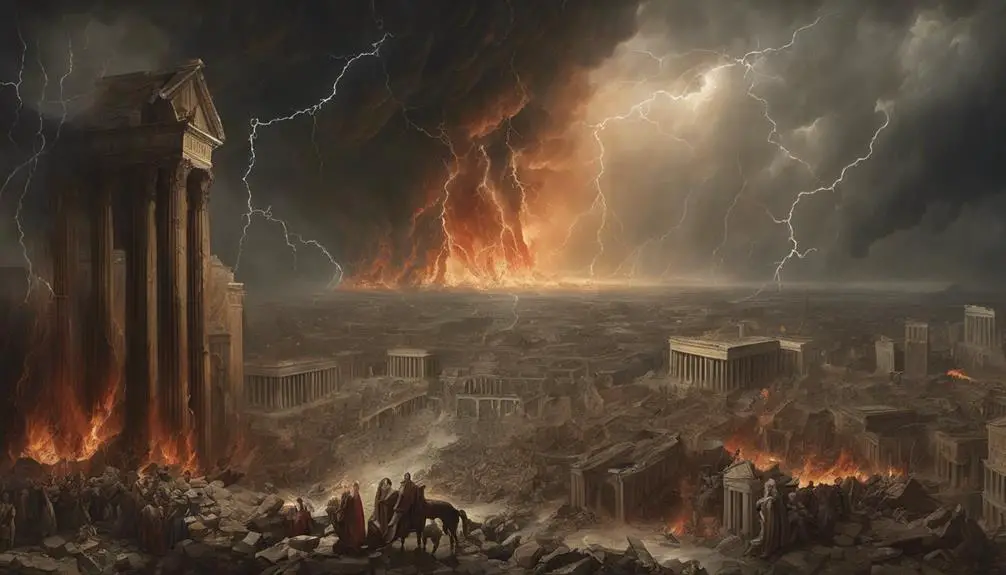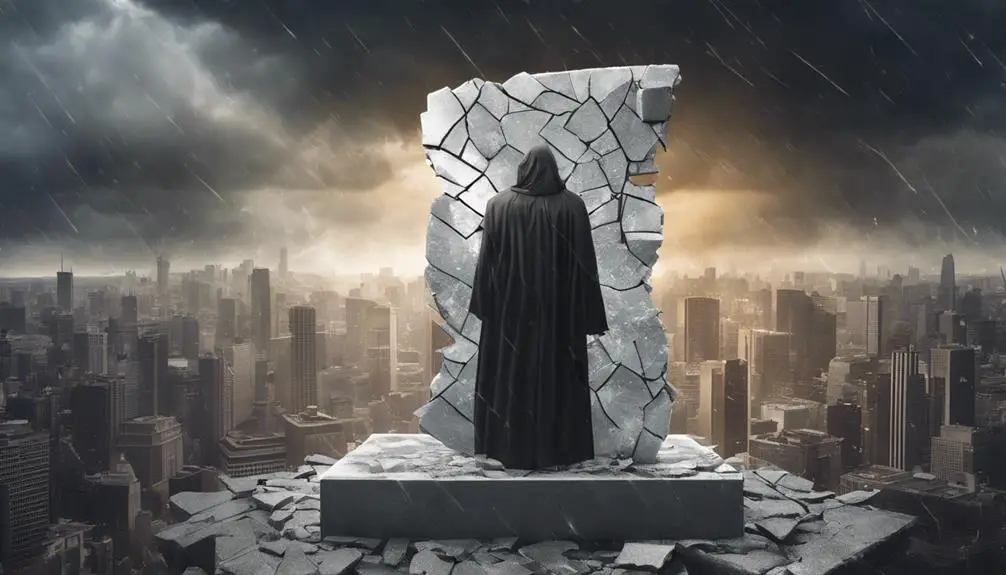Dive into the enigmatic exploration of destruction's role in the Bible, unearthing divine plans and life's trials.

Spirit of Destruction in the Bible
Have you ever pondered the presence of destruction within the sacred pages of the Bible? You'd probably associate the Bible with creation, guidance, love, and redemption. Yet, it's equally brimming with instances of destruction, both physical and spiritual.
As you peel back the layers, you'll find that unraveling the mysteries of this 'Spirit of Destruction' can offer a profound understanding of the divine plan and the nature of life's trials. Let's embark on this exploration, shall we?
Key Takeaways
- Destruction in the Bible is often a result of divine punishment and apocalyptic prophecies.
- The Old Testament links destruction to human disobedience, while the New Testament views it as a means of spiritual growth.
- Notable instances of biblical destruction include the devastation of Sodom, Gomorrah, and Nineveh, and the prophetic warnings in Revelation.
- The biblical theme of destruction remains relevant today, providing a framework to interpret global crises and personal trials.
Exploring Biblical Destruction Concepts

Diving into the myriad concepts of destruction presented in the Bible, you'll find a wealth of interpretations, each carrying its own unique implications and nuances. Yet, two themes consistently emerge amidst this diversity: divine punishment and apocalyptic prophecies.
The theme of divine punishment is pervasive throughout the Bible. It's a notion deeply ingrained in the Judeo-Christian consciousness, reflecting the idea that God's wrath is a response to disobedience or sin. In these instances, destruction is depicted not as random or arbitrary, but as a calculated consequence of human actions.
On the other hand, apocalyptic prophecies present a more cataclysmic perspective on destruction. These aren't just warnings or reprimands; they're predictions of world-ending events triggered by divine decree. The Book of Revelation, for instance, is replete with imagery of the apocalypse, presenting a future where celestial bodies collide, nature rebels, and the world as we know it ceases to exist.
Old Testament Perspectives

To further understand these themes of destruction, let's now turn our focus towards the Old Testament, examining its unique perspectives and interpretations. The Old Testament is replete with instances of Divine Judgement and Prophetic Warnings, which often precede destruction.
A characteristic example is the destruction of Sodom and Gomorrah (Genesis 19), where the cities were judged for their wickedness and destroyed through Divine Judgement. Then there's the case of Noah's flood (Genesis 6-9), where prophetic warnings were given, but not heeded, leading to a cataclysmic flood.
Throughout these narratives, a pattern emerges: destruction often serves as a divine response to human disobedience, and Prophetic Warnings invariably precede such destruction. Here's a succinct table summarizing these findings.
Event |
Prophetic Warning |
Divine Judgement |
|---|---|---|
Sodom and Gomorrah |
Yes |
Yes |
Noah's Flood |
Yes |
Yes |
In analyzing these Old Testament narratives, you'll notice that destruction isn't arbitrary or whimsical, but a deliberate divine act, often preceded by Prophetic Warnings and culminating in Divine Judgement. This perspective provides a richer understanding of the theme of destruction in the Bible.
New Testament Interpretations

While the Old Testament presents destruction as a divine response to human disobedience, you'll find the New Testament offers a nuanced interpretation of this theme. In the New Testament, destruction isn't merely punitive, it acts as a transformative device leading to spiritual growth and redemption.
Paul's writings, for instance, showcase this connotation. He often uses the motif of destruction as a metaphor for the believer's transition from the old, sinful self to a renewed, righteous self. This is portrayed through:
- The symbolic death and resurrection of the believer in baptism.
- The crushing of one's earthly desires to make way for heavenly aspirations.
- The metaphorical destruction of the flesh, signifying the end of sinful nature.
- The concept of the old self being crucified with Christ.
- The image of the believer as a new creation, rebuilt from the ruins of their old self.
Moreover, Apocalyptic Imagery in the New Testament signifies not just the end of the world, but also the advent of God's kingdom. Destruction, therefore, becomes a necessary precursor to divine restoration and renewal. Thus, the New Testament interpretation of destruction is both somber and hopeful, a testament to the transformative power of divine intervention.
Noteworthy Scriptural Examples

Let's delve into some explicit examples in Scripture where the theme of destruction holds significant meaning. Consider the prophetic warnings of the ancient city of Nineveh in the book of Jonah, where destruction symbolism is vividly portrayed. The threat of annihilation was imminent and palpable, but repentance changed that narrative.
Another noteworthy instance is the destruction of Sodom and Gomorrah in Genesis. It's a powerful depiction of divine justice and a sobering reminder of the consequences of unrepentant sin. The cities' annihilation serves as a symbol of God's judgment against pervasive wickedness.
Furthermore, you'll find the prophetic warnings in the book of Revelation compelling. The graphic imagery of the apocalypse, with its plagues, wars, and natural disasters, underscores the destructive power of sin and the ultimate triumph of God's righteousness.
In each of these cases, destruction wasn't arbitrary but tied to a divine purpose. It served to chastise, correct, or cleanse. These examples illustrate the complexity of the theme of destruction in the Bible, and how it's fundamentally a mechanism of divine justice and an instrument for moral and spiritual realignment.
Contemporary Relevance and Understanding

In the context of today's world, understanding the biblical theme of destruction has profound implications for our interpretation of contemporary events and moral dilemmas. The biblical symbolism associated with destruction isn't merely a relic of the past but continues to shape our cultural, social, and ethical landscapes. The modern implications of this theme are multifold:
- It can provide a lens through which to view global crises, such as wars and natural disasters.
- It can offer a framework for understanding societal upheaval and change.
- We can use it to interpret personal trials and tribulations.
- It can guide our responses to injustice and suffering.
- It can also challenge our perceptions of progress and development.
These examples illustrate that the biblical theme of destruction remains a relevant force in today's world, lending insight into the complexities of our modern existence. Therefore, it's essential to engage with this theme not as a static historical concept but as a dynamic and living reality.
Frequently Asked Questions
How Does the Concept of 'Spirit of Destruction' Relate to Other Religions Outside Christianity?
In exploring 'Spirit of Destruction' in religions outside Christianity, you'll find similar concepts. Destruction spirituality isn't unique to one belief system. Many religions acknowledge spirit manifestations that represent destructive forces.
It's seen as a necessary balance, part of life's cyclical nature. These destructive spirits often symbolize change, transformation, and the removal of what no longer serves us, making way for new growth.
What Psychological Impact Does the 'Spirit of Destruction' Have on Believers and Non-Believers Alike?
You might find that Destruction's Influence can cause a psychological impact on both believers and non-believers.
For believers, there could be a fear, a sense of impending doom. This Believer's Fear might make them more devout, hoping to ward off destruction.
For non-believers, it might cause anxiety or dismissal, as they don't adhere to the same beliefs but can't escape the societal implications.
How Is the 'Spirit of Destruction' Portrayed in Popular Culture, Such as in Movies, Music, and Literature?
You've likely seen destruction symbolism in popular culture – it's often dramatized in cinematic portrayals, music lyrics, and literature. Directors use it to create thrilling scenes, while authors and songwriters use it to evoke deep emotions. It's typically symbolic of upheaval, change, or the end of something.
Without knowing it, you're absorbing these themes and they can influence your perspective on life and society.
How Have Interpretations of the 'Spirit of Destruction' Changed Over Different Historical Periods?
Over time, interpretations of 'destruction symbolism' have shifted. In ancient societies, it often represented necessary change or cyclical patterns.
In the Middle Ages, it was viewed more negatively, linked to divine punishment.
Today, you might see it as a reflection of societal fears, like nuclear war or environmental collapse.
It's important to understand these changes to fully grasp the complexity of Biblical interpretation.
What Are Some Common Misconceptions or Myths Surrounding the 'Spirit of Destruction' in the Bible?
You might've heard various misconceptions about Destruction's Origin. Some believe it's inherently evil or linked to Satan. However, in Biblical Interpretations, it's not a malign entity but a divine tool used for judgement.
The notion that it's an independent force wreaking havoc is a common myth. In reality, it's under God's control and serves a specific purpose within a divine plan. Understanding this helps debunk many misconceptions.
Conclusion
In conclusion, the Bible's depiction of destruction isn't one-dimensional. It's a complex concept, intertwining both Old and New Testament narratives. From the Flood to the Apocalypse, these episodes offer profound insights into divine justice and mercy.
Understanding these instances helps us to navigate our contemporary struggles, reminding us that even in destruction, there's a spirit of renewal and hope. It's an enduring lesson with timeless relevance to our lives today.



Sign up